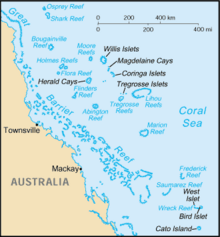Coringa-Herald National Nature Reserve
The Coringa-Herald National Nature Reserve is a marine sanctuary located in the Coral Sea about 400 km east of Cairns in Queensland , Australia . It was designated a protected area on August 16, 1982.
meaning
The Coringa-Herald National Nature Reserve is about 100 km from Lihou Reef National Nature Reserve removed. Both reserves are located in a sea area far from civilization, which does not belong to the Great Barrier Reef to the east and is called the Queensland Trough . Both protected areas are part of the 17,290 km Coral Sea Reserves Ramsar Site , which, according to the international Ramsar Convention, represent wetlands of international importance. It is also a significant Important Bird Area , a bird sanctuary, on six small islands.
history
The coral banks (English: Cays) and Islets (islets) in the Coral Sea were discovered by Europeans in the early 1800s. The Coringa Islets was named after the sailing ship Coringa Packet , which sank there in 1845. The Herald Cays was named after the ship HMS Herald , which carried out hydrographic surveys between 1849 and 1861 . Guano was mined on Chilcott Islet during the 1860s . In the early 1960s, the first scientific research into this area took place, which led to its protection.
geography
The marine reserve with 8,856 km² of open water comprises three pairs of small islands:
- Herald Cays : North East and South West Cay
- Coringa Islets : Chilcott and South West Islet
- Magdelaine Cays : South East Cay and North West Islet
The pairs of islands are located on a separate platform of the reef system in a deep sea, each presenting an individual reef formation that varies in size from 16 to 37 hectares and covers a total area of 124 hectares. Every island has a reef surrounding it and is exposed to the influence of the ocean and its waves.
The islands were formed by coral debris, rocks and debris and do not tower more than five meters above sea level. South-East Magdelaine Cay is the largest of the islets, and parts of it, like North-East Herald Cay , are covered in dense forest of Pisonia grandis and Cordia subcordata trees. Except for the North-West Magdelaine Islet , which has no vegetation, grasses and velvet-leaf bushes ( Heliotropium foertherianum ) grow on the other islets.
Flora and fauna
The marine reserve is important because of its significant islands and their ecological reef system and their deep sea habitats with an unusual underwater topography and extraordinary reef structures. It has a rich marine flora and fauna characteristic of a large marine area, with potentially undiscovered endemic species. The flora and fauna of this sea area is different from the Great Barrier Reef , which lies to the west. There are fish, hermit crabs , starfish , various algae, corals, sea urchins and sea cucumbers . The protected green turtle , dolphins and whales are also found.
1% of the world population of the wedge-tailed shearwater ( Puffinus pacificus ), red-footed boobies , ariel frigatebirds , red-tailed tropical birds and white-headed noddis ( Anous minutus ) breed there .
Together with the Lihou Reef National Nature Reserve, the islands form an internationally significant bird sanctuary. 17 of the 27 bird species that were counted in the protected area are listed internationally in the Japan Australia Migratory Birds Agreement and the China Australia Migratory Birds Agreement .
literature
Anon: Coringa-Herald National Nature Reserve and Lihou Reef National Nature Reserve: Management Plan . Environment Australia, Canberra 2001, ISBN 0 6425476 6 1 .
Web links
- environment.gov.au (PDF; 435 kB): Coral Sea, National Nature Reserve (information brochure) (English)
- environment.gov.au : Location map of the Coral Sea Conservation Zone with Coringa-Herald National Nature Reserve (English)
Individual evidence
- ↑ a b c d environment.gov.au ( Memento of the original from August 14, 2011 in the Internet Archive ) Info: The archive link was inserted automatically and has not yet been checked. Please check the original and archive link according to the instructions and then remove this notice. : Coringa-Herald National Nature Reserve, in English, accessed August 7, 2011
- ↑ a b Anon (2001): see literature.
- ↑ birdata.com.au : Coringa-Herald Reefs , in English, accessed on August 7, 2011
Coordinates: 16 ° 58 ′ 0 ″ S , 149 ° 58 ′ 0 ″ E




